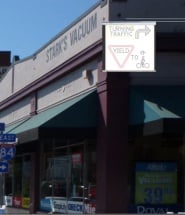
NE Couch at Grand.
(Image: PBOT)
Back in August, Portlander Owen Spencer was right-hooked while traveling westbound on NE Couch at the intersection of NE Grand. Unfortunately, Spencer’s experience was far too common. That intersection is well-known by riders and by the Portland Bureau of Transportation as a hot-spot for bike/car collisions.
PBOT had already installed green pavement markings and a bike box at the intersection, but after Spencer’s collision — and the community outcry that followed — they realized more needed to be done.
In the months since, PBOT has analyzed the intersection and today they released a solution: A new, illuminated traffic sign will be installed on the northwest corner of the intersection that will implore people operating cars in the right turn lane to yield to westbound bicycle traffic. (According to PBOT counts, in the AM peak there are 120 bikes per hour that travel straight through the Couch/Grand intersection and 127 cars that turn right.)
Here’s a close-up of the sign:

And here’s how it looks in context of the street:
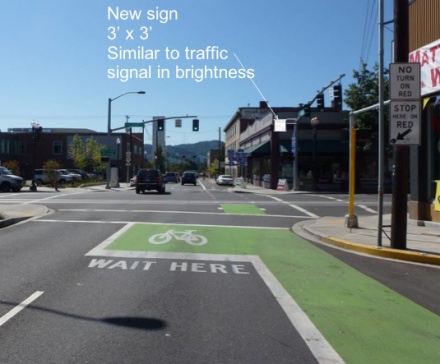
PBOT spokesperson Dan Anderson shared this statement today via email:
“The Bureau of Transportation has been working to make West [sic] Burnside and Couch as safe as possible since the couplet was completed. We’re pleased to introduce a new sign that will make it clear that drivers must yield to those biking to their lane when turning right. This sign will be in addition to the green bike box already installed at NE Couch and Grand.”
Anderson says they expect to install the new sign in late November.


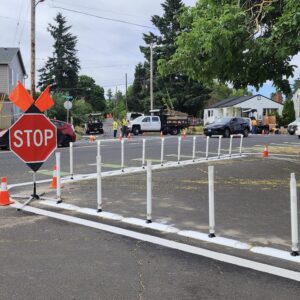

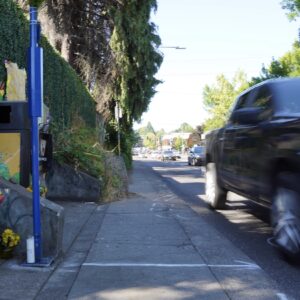
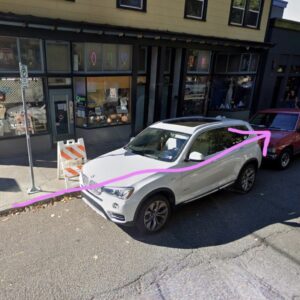
Thanks for reading.
BikePortland has served this community with independent community journalism since 2005. We rely on subscriptions from readers like you to survive. Your financial support is vital in keeping this valuable resource alive and well.
Please subscribe today to strengthen and expand our work.
Passing a right-turning vehicle on the right seems so insane to me… why is this considered a good design? Wouldn’t it be better if turning cars and bikes traveled through intersections like this single file? More of a merge than a yield on right. That is how I generally navigate intersections such as this.
I’m so ambivalent on this issue.
I like being able to pass on the right when traffic goes straight through the intersection but I also agree with nearly all of the tenets of Vehicular Cycling.
It is obvious that drivers need to be reminded of their legal duties regarding the safety of other road users and am dismayed that it is needed.
My policy, when passing cars in a bike lane, is to 1st look for turn signals then lane positioning and finally vehicle orientation as indicators of who is going to turn.
For example on my commute home at TV Hwy crossing Murray the right most lane is not right turn only but is functionally so. Users either turn right or are speeding through to cut in front of the main traffic lanes. When I approach a line of stopped cars I will go no further in the bike lane then the first car that is not indicating or acting as if they will turn right. I position my bike such that the drivers in front can see my bike in at least one of their mirrors.
While stopped I then make EYE CONTACT with the driver I’ve assumed is going straight and hand signal to inquire if they are turning and to indicate I am going straight.
This requires a conscious effort every time and a dedicated level of paranoia but I feel that it has kept me from injury for many years.
I also have only gotten positive feedback from drivers when I have plainly indicated my intentions in situations where they might be confuse and thus frightened.
sometimes you’re traveling beside the vehicle and not passing it…
Well, if it’s yielding to you, you are at some point passing it.
Another bandaid on a super-poor design isn’t going to help, especially that tiny sign.
PDOT needs to ether move the bike lane to the left of a right-turn-only lane, or eliminate the bike lane entirely and install sharrows left-of-center in the right lane.
it’s not a right-turn only lane…
also, you’re not required to use the bike lane if it’s to the right of a right-turn only lane…
the safer choice is to take the travel lane. you cannot rely on motorists to signal intended turns. the only time in recent memory i have come close to being right hooked was crossing MLK at shaver, starting to pass to the right of a car that had its left turn signal on and was waiting for oncoming traffic to clear. suddenly he changed his mind.
I get the feeling this sign would make people think that particular yield is required at that intersection but isn’t the law for every other intersection in the city.
BURR, what makes it a super-poor design? There are two through lanes and you can make a right turn out of the right lane. Pretty standard. It would be interesting to see the through volumes on Couch and how much of that volume is in the shared lane. I don’t think that 127 vehicles per hour turning right makes that a de-facto right-turn lane, but the 120 bikes per hour is impressive.
It seems to me that the real problem is people driving cars not being attentive to people riding bikes AND people riding bikes not being attentive to people driving cars. Hopefully the sign will help.
I use both modes on a regular basis and I can say that it DEFINITELY goes both ways.
Putting cyclists to the right of right turning traffic makes it a super poor design, isn’t that abundantly clear from the number of crashes and the need for this sign?
I ride though here every morning, and I’ve witnessed two near misses and one crash. The only safe way through is to (technically illegally) take the lane.
It’s not illegal. Take the lane legally anytime the bike lane is not safe. If there is a high incidence of right hooks, it’s obviously not safe.
I take it every morning, too. The problem with taking the lane is that the cars are so lined up (at least at rush hour) that is basically impossible to squeeze yourself in between cars.
This kind of a sign will be as ignored as every other “yield to bikes” sign out there. The only way to make passing right-turning cars on the right safer is to have separate signal phases for bikes and cars. Problem with that, though, is that cars will assume they can turn right on red, just like at 99% of intersections regardless of whether “NO TURN ON RED” signs are posted (such signs would be ignored just like the proposed “YIELD” signs), and many cyclists would run a red bike signal seeing the motor signal was green.
This leaves us with the only really safe option here (as already mentioned by several others): merge into the through lane if you are going straight through.
It seems ridiculous that we have to continually post signs to remind road users of rules/laws they should already know. It also seems ridiculous that we employ initial designs for “infrastructure” that later require “band-aids” (to borrow a term from above comments) to try to make them safer, which band-aids will actually fail to make the initial design any safer, but we will refuse to redesign anything to actually BE safer….
Somebody in a different article recently linked to a post on copenhagenize that railed against the “sect” of VC, claiming that it actively opposed any kind of “bike infrastructure”. Several commenters on that post expressed the sentiment that they used VC principles because they had to due to non-existent or vastly inferior “facilities” (impediments) for cycling. These folks are not opposed to bike infrastructure, they (and I) are opposed to crappy infrastructure that is actually more dangerous than nothing.
In the US–even in Portland–we seem to sit on a fence between good bike infrastructure and no bike-specific infrastructure, which actually leaves us with the worst of all possible worlds. Designs that are so complicated to understand that we have to have extra sign-clutter to attempt to explain on the fly how a particular intersection or route is supposed to work, routing that looks inviting but actually expects/requires cyclists to abandon their status as vehicles and become pedestrians, designs and routes that we tout as “separated” and “safe”, but which are really only separated for short distances or are actually more dangerous due to poor road crossings or proximity to pedestrians (MUPs) or parked cars (door zone bike lanes), etc. It is downright exasperating.
Wow. Did not intend to be that long-winded. Sorry.
I’m not sure that I agree that installing separate signals for cars and bikes won’t work. Seems to work pretty well at the west end of the Broadway Bridge.
The solutions is easy. NO RIGHT TURN. Cars can go around the block on three left turns. This should be the rule anywhere a bike it relegated (by law!) to be in the bike lane to the right of cars.
Or separate signals. One for thru traffic combined with a bike signal, and one for right-turning cars. Also move the traffic lights back and position them where you actually want the cars to stop with the lights at eye level. Why put them on the other side of the intersection? Seems backwards.
I’m pretty disappointed that PBOT thinks the solution to the serious problems at this intersection is yet another sign.
The intersection needs a redesign so that bikes and cars are properly channelized either in space or in time (bike signal, or moving the bike lane out of the way of right turns).
I always take the lane on the cargo bike especially through this particular section. It is required. All traffic rolls extremely smoothly when I do this. To attempt straight through on green in the bike lane could not be more dangerous and forces cars to be impeded unnecessarily.
It’s a high speed route where bikes can easily go faster than motorists assume they do/can. Everything happens quickly on this downhill lead up to the bridge.
Seems like making the left two lanes through-only and the bicycle lane the only lane that permits turns would be brighter than band-aiding this intersection over and over.
Say it with me now: “NO RIGHT TURN EXCEPT BICYCLES”
Perfect Christmas gift for PBOT: a copy of Edward Tufte’s Visual Explanations
Amen to that! It’s too noisy, too detailed and no clear relevance to the situation…
A big fat yield with Bicycle traffic would have been easier…
We’ll see if this helps.
A quick look through the MUTCD (Manual of UNIFORM Traffic Control Devices) shows no neon message signs for signalized intersections. But Portland has them up all over town, so there’s a precedent for them.
But, there’s a big difference between this sign and the other signs. Other such “illuminated” signs at traffic signals are used to reflect a permission/restriction ONLY AT CERTAIN TIMES. Such as
* a certain part of the traffic cycle (no right turn on red when MAX is going by),
* a certain time of day, or
* other changing conditions (Main Street closed west of Broadway, so “no right turn”)
The sign merely states the conditions present at all intersections at all times in the whole State of Oregon.
Thus fails the “uniformity” test. And could cause the problems of drivers assuming that since no other intersections have this sign, that this is the only place where bikes DO have the right of way.
But it still might work.
Thanks for experimenting, PBOT, and if this doesn’t help, let’s do something else.
Ted Buehler
I am excited to see this. This intersection has been a continuing frustration for me daily as a bike rider.
One thing that still gets my goat though – why the “NO TURN ON RED” sign is stuck up BEFORE the bike box, rather than on the far side of the intersection, where motorists can actually READ it as they are stopped at the intersection. You can clearly see what I mean in your photo accompanying the article here.
If PBOT had moved that NO TURN ON RED sign to the far side of the intersection, to hang on the traffic light poles instead, I bet compliance would be much higher with motorists.
Let’s not forget one more thing here – if Ankeny Street were not such a car-centric crap-hole of a bike boulevard, cyclists would not be forced to use dangerous streets like Burnside and Couch to access the Burnside Bridge.
Let’s get some more diverters on Ankeny Street NOW, and eliminate the need for bicycling on Couch in the first place.
Where would you have west bound cyclists access the Burnside bridge?
I use Ankeny until 8th, then cut over to Couch. I prefer this to being stuck with the backed up cars on Grand, where I can get stuck for an extra light cycle with the cars. Neither route is low stress.
What if parking and the curb extension were removed in that last block, and the bike lane was converted to a combined turn lane for vehicles and through lane for bikes? Bikes would still receive the benefit of passing some cars when traffic is backed up, but at the point of the turn, bikes would become single file with cars. It would be slower for bikes, but safer for the people on bikes too inexperienced to watch for right hooks.
As an aside, not all impending right hooks are obvious, but most are. But I will agree that “adequate” bike infrastructure does not put inexperienced riders at a high risk, and this intersection does exactly that. Even if it is reasonable for experienced riders.
The problem is that this facility (I hesitate to call it an ‘improvement’) was designed specifically for less experienced cyclists in the first place, and now more experienced riders are forced to use it as well, or risk having to defend their choice not to use it in court.
If a car has a turn signal on indicating they are taking a right and a cyclist comes from behind on their right who has the right of way?
A: The cyclist. Iff there is a bike lane.
If there is a bike lane, you can think of it like this: if a driver wants to change lanes from the left lane to the right lane, has their turn signal on, but another CAR is overtaking them from behind on their right, who has the right of way? When there is a bike lane (even if the stripe disappears through an intersection, despite what a certain local pro-tem judge thinks), it is to be treated like any other lane of traffic for right-of-way purposes, except that cars may not enter it except in the process of actually making a turn–not leading up to or preparing to make a turn–only when actually turning the corner.
Otherwise, in the absence of a bike lane, I believe the right-turning driver would have the right-of-way.
I see this very thing as part of the confusion about Portland’s mish-mash of bike facilities.
With auto travel lanes, you’ll NEVER see a right turn lane to the LEFT of another lane that can go straight. You’ll only see that if both the lanes are turning.
Bike infrastructure has been built all over Portland that allows cyclists to move independently of cars in their own lane, the bike lane. Just like in auto lanes – you don’t usually stop in your lane because someone in the next lane over needs to CROSS OVER YOUR LANE to make a turn – that is just silly planning.
I’d imagine a very large majority of cyclists going down Couch this far are going to continue straight to go across the Burnside bridge, rather than turn right onto Grand.
Therefore putting another travel lane in (the bike lane) that is for all intents and purposes a straight-through lane to the right of a vehicle right turn lane is massively stupid, as you’ll get “right of way” conflicts and inevitable collisions between cars and bikes.
It doesn’t matter how many *useless* signs you put up, or how vigilant cyclists and drivers try to be – even good people screw up and can be the cause of a collision.
This particular treatment, designed to make people feel safer, will actually wind up harming more people.
Portland should immediately remove the bike lane/box here and mark the entire right lane down Couch with sharrows. Taking the lane here is the only safe option to avoid conflict and right-hooks IMHO.
Legally, the bike has the right of way. However, common sense would dictate that you let them go first. I’d rather be alive than dead right.
My first thought was that drivers don’t look at signs, but if it’s as bright as the picture suggests, maybe it will get some attention. And then once those who drive through there on a regular basis get used to it, they won’t see it any longer.
A few months ago, the main road out to my neighborhood was widened and two school zone signs were replaced with yellow lights that flash when the 20 mph is in effect. People still slow down to 20 even when the lights don’t flash. People (all people, not just drivers) can be pretty darn oblivious.
They need to put down rubmle strips that draw attention to a pavement marking that announces a flashing light that alerts motorists to the new warning sign.
Anything less would only be easily ignored clutter
rumble strips are a very bad idea as they are a hazard to any cyclist who may need to cross them
I recommend adding a bicycle pavement stencil (without the arrow) on the green bike lane right at the point where cars turn across the bike lane. This treatment is used in Denmark quite a bit at intersections and driveways; I think the symbol unconsciously makes drivers feel like there are more cyclists on the road, and this is “the” point where you’re mostly likely to run into one.
“West Burnside”?
I think the only thing that will help is either a “strict liability” law, or a “hit a vulnerable user, lose your car” variation on that that seizes the car whenever there’s a wreck, and only releases it when the driver is found to not be at fault with no safety violations for the condition of the vehicle. The way that would work is the vehicle is impounded at the scene and examined for safety defects that might have contributed to the wreck, if the driver is at fault or if something wrong with the vehicle contributed to the wreck the car is crushed and sold for recycling. If there was a defect and the vulnerable user caused the wreck then the vulnerable user gets a ticket and the car gets crushed. And couple that with making hit-and-run always the fault of the vehicle operator that leaves the scene (with some caveats, I’m still working on that one) and bike-v-car wrecks would be as low as they are in the Netherlands.
Except you might run into a serious problem with the 5th amendment of the US constitiution which states that no can be deprived of their property without due process of law. If the vehicle is in question is evidence, than the police can hold itin evidenece until the case is adjudicated. I can’t imagine too many cases where the actual car would be entered into evidence (photos of damage, accident reconstruction drawings, testimony of expert mechanics who had examined the vehicle, would be seen as less burdensome substitutes).
And for about the same price, PBOT could have installed a bike light similar to the one on Broadway and Williams.